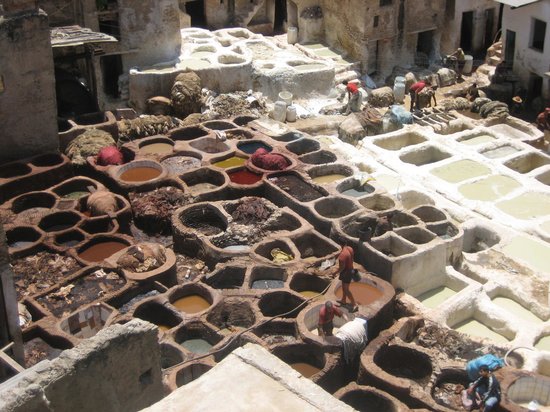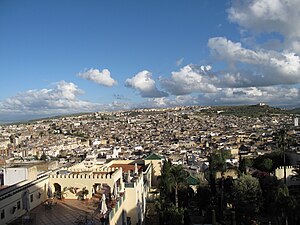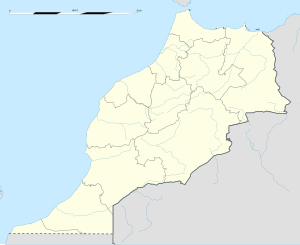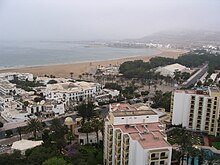 Tangier
Tangier (
//; Arabic:
طنجة
Ṭanjah; Berber: ⵟⴰⵏⵊⴰ
Tanja or (archaic)
Tingi; French:
Tanger; Spanish:
Tánger; Portuguese:
Tânger and usually
Tangiers in British English,) is a city in northern Morocco with a population of about 850,000 (2012 estimates). It is located on the North African coast at the western entrance to the Strait of Gibraltar where the Mediterranean Sea meets the Atlantic Ocean off Cape Spartel. It is the capital of the Tangier-Tetouan Region and of the Tangier-Asilah prefecture of Morocco.
The history of Tangier is very rich due to the historical presence of
many civilizations and cultures starting from the 5th century BC.
Between the period of being a Berber settlement and then a Phoenician
town to the independence era around the 1950s, Tangier was a refuge for
many cultures. In 1923, Tangier was considered as having international status by foreign colonial powers, and became a destination for many European and American diplomats, spies, writers and businessmen.
The city is currently undergoing rapid development and modernization.
Projects include new 5-star hotels along the bay, a modern business
district called Tangier City Center, a new airport terminal and a new
football stadium. Tangier's economy is also set to benefit greatly from
the new Tanger-Med port.
Tangier's sport team I.R.T. (or
Ittihad Riadi de Tanger) is a prominent football club with a large following base. Tangier will be one of the host cities for the 2015 Africa Cup of Nations football tournament, which shall be played at the new Ibn Batouta Stadium and in other cities across Morocco.
History
Tangier was founded by
Carthaginian colonists in the early 5th century BC.
The Greeks ascribed its foundation to the giant
Antaios, whose tomb and skeleton are pointed out in the vicinity, calling Sufax the son of
Hercules
by the widow of Antaeus. The cave of Hercules, a few miles from the
city, is a major tourist attraction. It is believed that Hercules slept
there before attempting one of his
twelve labours.
The commercial town of
Tingis (Τιγγίς in
Ancient Greek), came under
Roman rule in the course of the 1st century BC, first as a free city and then, under Augustus, a colony (
Colonia Julia, under Claudius), capital of Mauritania Tingitana of Hispania. It was the scene of the martyrdoms of Saint Marcellus of Tangier. In the 5th century AD, Vandals conquered and occupied "Tingi" and from here swept across North Africa.

A century later (between 534 and 682), Tangier fell back to the Eastern Roman empire, before coming under Arab (Umayyad) control in 702. Due to its Christian past, it is still a titular see of the Roman Catholic Church.
When the Portuguese, driven in good part by religious fervor, started their colonial expansion by taking Ceuta in 1415,
Tangier was always a primary goal. They failed to capture the city in 1437 but finally occupied it in 1471 (see List of colonial heads of Tangier). A partial plan of the original kasbah (Arabic: القصبة
al-qaṣbah) was found in 2009-12, in a Portuguese document now preserved in the Military Archives of Sweden in Stockholm (Krigsarkivet (Riksarkivet)).
The Portuguese rule (including Spanish rule during the Iberian Union, 1580–1640) lasted until 1662, when it was given to Charles II of England as part of the dowry from the Portuguese Infanta Catherine of Braganza, becoming English Tangier.
The English gave the city a garrison
and a charter which made it equal to English towns. The English planned
to improve the harbour by building a mole. With an improved harbour the
town would have played the same role that Gibraltar
later played in British naval strategy. The mole cost £340,000 and
reached 1,436 feet long, before being blown up during the evacuation.
An attempt of Sultan Moulay Ismail
of Morocco to seize the town in 1679 was unsuccessful; but a crippling
blockade imposed by him ultimately forced the English to withdraw. The
English destroyed the town and its port facilities prior to their
departure in 1684. Under Moulay Ismail the city was reconstructed to some extent, but it gradually declined until, by 1810, the population was no more than 5,000.

View of the old medina of tangier
The United States dedicated its first consulate in Tangier during the George Washington administration.
[7] In 1821, the Legation Building in Tangier became the first piece of property acquired abroad by the U.S. government—a gift to the U.S. from Sultan Moulay Suliman. In 1828, Great Britain blockaded the port in retaliation for piracy.
It was bombarded by the French Prince of Joinville in 1844.
Italian revolutionary hero Giuseppe Garibaldi lived in exile at Tangier in late 1849 and the first half of 1850, following the fall of the revolutionary Roman Republic.
Tangier's geographic location made it a centre for European diplomatic and commercial rivalry in Morocco in the late 19th and early 20th centuries.
By the opening of the 20th century, it had a population of about
40,000, including 20,000 Muslims, 10,000 Jews, and 9,000 Europeans (of
whom 7,500 were Spanish). The city was increasingly coming under French
influence, and it was here in 1905 that Kaiser Wilhelm II triggered an international crisis that almost led to war between his country and France by pronouncing himself in favour of Morocco's continued independence.
In 1912, Morocco was effectively partitioned between France and Spain, the latter occupying the country's far north and far south, while France declared a protectorate over the remainder. The last Sultan of independent Morocco, Moulay Hafid, was exiled to the Sultanate Palace in the Tangier Kasbah after his forced abdication in favour of his brother Moulay Yusef.
Tangier was made an international zone in 1923 under the joint administration of France, Spain, and Britain
under an international convention signed in Paris on December 18, 1923.
Ratifications were exchanged in Paris on May 14, 1924. The convention
was registered in
League of Nations Treaty Series on September 13, 1924.
The convention was amended in 1928.
The governments of Italy, Portugal and Belgium adhered to the convention in 1928, and the government of the Netherlands in 1929.
The International zone of Tangier had a 373 square kilometer area and, by 1939, a population of about 60,000 inhabitants.
Spanish troops occupied Tangier on June 14, 1940, the same day Paris fell to the Germans. Despite calls by the writer Rafael Sánchez Mazas and other Spanish nationalists to annex "
Tánger español", the Franco regime publicly considered the occupation a temporary wartime measure.
A diplomatic dispute between Britain and Spain over the latter's
abolition of the city's international institutions in November 1940 led
to a further guarantee of British rights and a Spanish promise not to
fortify the area.The territory was restored to its pre-war status on October 11, 1945.
[15] Tangier joined with the rest of Morocco following the restoration of full sovereignty in 1956.
Ecclesiastical history
Originally, the city was part of the larger province of Mauretania Caesariensis,
which included much of Northern Africa. Later the area was subdivided,
with the eastern part keeping the former name and the newer part
receiving the name of Mauretania Tingitana. It is not known exactly at
what period there may have been an episcopal see at Tangier in ancient
times, but in the Middle Ages Tangier was used as a titular see (i.e., an honorific fiction for the appointment of curial and auxiliary bishops), placing it in Mauretania Tingitana. For the historical reasons given above, one official list of the Roman Curia places the see in Mauretania Caesarea.
Towards the end of the 3rd century, Tangier was the scene of the martyrdom of Saint Marcellus of Tangier, mentioned in the Roman Martyrology on 30 October, and of St. Cassian, mentioned on 3 December.
Under the Portuguese domination, there was a Bishop of Tangier who was a suffragan of Lisbon but in 1570 the diocese was united to the diocese of Ceuta.
Six Bishops of Tangier from this period are known, the first, who did
not reside in his see, in 1468. During the era of the protectorate over
Morocco, Tangier was the residence of the Prefect Apostolic of Morocco, the mission having been founded on November 28, 1630, and entrusted to the Friars Minor.
At the time it had a Catholic church, several chapels, schools, and a
hospital. The Prefecture Apostolic was raised to the status of a Vicariate Apostolic of Marocco April 14, 1908, and on November 14, 1956, became the Archdiocese of Tangier.
The city also has the Anglican church of Saint Andrew.
Espionage
Tangier has been reputed as a safe house for international spying activities.
Its position during the Cold War and other spying periods of the 19th and 20th centuries is legendary.
Tangier acquired the reputation of a spying and smuggling centre and
attracted foreign capital due to political neutrality and commercial
liberty at that time. It was via a British bank in Tangier that the Bank of England in 1943 for the first time obtained samples of the high-quality forged British currency produced by the Nazis in "Operation Bernhard".
The city has also been a subject for many spy fiction books and films (see Tangier in popular culture below).
Climate
Tangier has a subtropical mediterranean climate (Köppen
Csa)
with heavier rainfall than most parts of North Africa owing to its
exposed location. The summers are hot and sunny and the winters are
occasionally wet but very mild: frost is unknown.
| Climate data for Tangier (1961-1990) |
|---|
| Month |
Jan |
Feb |
Mar |
Apr |
May |
Jun |
Jul |
Aug |
Sep |
Oct |
Nov |
Dec |
Year |
| Average high °C (°F) |
16.2
(61.2) |
16.8
(62.2) |
17.9
(64.2) |
19.2
(66.6) |
21.9
(71.4) |
24.9
(76.8) |
28.3
(82.9) |
28.6
(83.5) |
27.3
(81.1) |
23.7
(74.7) |
19.6
(67.3) |
17.0
(62.6) |
21.78
(71.21) |
| Average low °C (°F) |
8.4
(47.1) |
8.8
(47.8) |
10.1
(50.2) |
11.2
(52.2) |
13.4
(56.1) |
16.2
(61.2) |
18.7
(65.7) |
19.1
(66.4) |
18.3
(64.9) |
15.6
(60.1) |
12.2
(54) |
9.5
(49.1) |
13.46
(56.23) |
| Rainfall mm (inches) |
103.5
(4.075) |
98.7
(3.886) |
71.8
(2.827) |
62.2
(2.449) |
37.3
(1.469) |
13.9
(0.547) |
2.1
(0.083) |
2.5
(0.098) |
14.9
(0.587) |
65.1
(2.563) |
134.6
(5.299) |
129.3
(5.091) |
735.9
(28.974) |
| Avg. rainy days (≥ 1.0 mm) |
11.2 |
11.4 |
10.1 |
9.3 |
6.1 |
3.7 |
0.8 |
0.8 |
3.1 |
8.0 |
11.1 |
12.0 |
87.6 |
| Mean monthly sunshine hours |
170.5 |
169.5 |
232.5 |
252.0 |
297.6 |
306.0 |
344.1 |
331.7 |
276.0 |
238.7 |
180.0 |
167.4 |
2,966 |
| Source: Hong Kong Observatory[18] |
Culture
The multicultural placement of
Muslim,
Christian, and
Jewish communities and the foreign immigrants attracted writer and composer
Paul Bowles, playwright
Tennessee Williams, the beat writers
William S. Burroughs,
Allen Ginsberg and
Jack Kerouac, the painter
Brion Gysin and the music group the
Rolling Stones, who all lived in or visited Tangier during different periods of the 20th century.
The writer
George Orwell and his wife (travelling as Mr. & Mrs. Blair) visited Tangier in September, 1938. Orwell reported newspapers on sale: "
La Press Morocain, strongly pro-Franco;
Le Petite Morocain, impartial;
La Dépêche Morocain, somewhat pro-Franco;
Le Journal De Tanger (sic), seemingly non-political;
Tangier Gazette & Morocco Mail,
an English weekly, slightly antifascist and strongly anti-Japanese." He
also noted "There are four post offices, one French, one British, and
two Spanish - Franco and government. Stamps are British surcharged
Tangier. Coinage as in French Morocco."
[20]
It was after
Delacroix
that Tangier became an obligatory stop for artists seeking to
experience the colors and light he spoke of for themselves—with varying
results.
Matisse
made several sojourns in Tangier, always staying at the Grand Hotel
Villa de France. "I have found landscapes in Morocco," he claimed,
"exactly as they are described in Delacroix's paintings." The
Californian artist
Richard Diebenkorn was directly influenced by the haunting colors and rhythmic patterns of Matisse's Morocco paintings.
Antonio Fuentes was born in Tangier in 1905 from a Spanish family. An
article in La Gazette du Maroc described Antonio Fuentes as the Picasso
of Tangier,
[21] and he died in the city 90 years later.
[22]
In the 1940s and until 1956 when the city was an
International Zone, the city served as a playground for eccentric millionaires, a meeting place for
secret agents and all kinds of crooks, and a mecca for speculators and gamblers, an Eldorado for the fun-loving "Haute Volée". During
World War II the
Office of Strategic Services operated out of Tangier for various operations in North Africa.
[23]
Around the same time, a circle of writers emerged which was to have a profound and lasting literary influence. This included
Paul Bowles, who lived and wrote for over half a century in the city,
Tennessee Williams and
Jean Genet as well as
Mohamed Choukri (one of
North Africa's most controversial and widely read authors),
Abdeslam Boulaich,
Larbi Layachi,
Mohammed Mrabet and
Ahmed Yacoubi. Among the best known works from this period is Choukri's
For Bread Alone.
Originally written in Classical Arabic, the English edition was the
result of close collaboration with Bowles (who worked with Choukri to
provide the translation and supplied the introduction).
Tennessee Williams described it as "a true document of human desperation, shattering in its impact." Independently,
William S. Burroughs lived in Tangier for four years and wrote
Naked Lunch, whose locale of
Interzone is an allusion to the city.
After several years of gradual disentanglement from Spanish and
French colonial control, Morocco reintegrated the city of Tangier at the
signing of the
Tangier Protocol on October 29, 1956. Tangier remains a very popular tourist destination for cruise ships and day visitors from
Spain and
Gibraltar.
Economy
Tangier is Morocco's second most important industrial centre after
Casablanca. The industrial sectors are diversified:
textile,
chemical,
mechanical,
metallurgical and
naval. Currently, the city has four
industrial parks of which two have the status of
free economic zone (see
Tangier Free Zone).
Tangier's economy relies heavily on
tourism.
Seaside resorts have been increasing with projects funded by
foreign investments.
Real estate and
construction
companies have been investing heavily in tourist infrastructures. A bay
delimiting the city centre extends for more than 7 kilometres (4
miles). The years 2007 and 2008 will be particularly important for the
city because of the completion of large construction projects currently
being built. These include the Tangier-Mediterranean port ("
Tanger-Med")
and its industrial parks, a 45,000-seat sports stadium, an expanded
business district, and a renovated tourist infrastructure.
Agriculture in the area of Tangier is tertiary and mainly cereal.
The infrastructure of this city of the
strait of Gibraltar consists of a
port that manages flows of goods and travellers (more than one million travellers per annum) and integrates a
marina with a
fishing port.
Artisanal trade in the
old medina (old city) specializes mainly in
leather working, handicrafts made from wood and silver, traditional clothing, and shoes of Moroccan origin.
The city has seen a fast pace of
rural exodus
from other small cities and villages. The population has quadrupled
during the last 25 years (1 million inhabitants in 2007 vs. 250,000 in
1982).
[citation needed]
This phenomenon has resulted in the appearance of peripheral suburban
districts, mainly inhabited by poor people, that often lack sufficient
infrastructure. The city's
postcode is 90 000.
Notable landmarks

American Legation entrance
- Dar el Makhzen (Sultan's palace)
- Tangier American Legation Museum
- Museum of Moroccan Arts and Antiquities
- Museum of Contemporary Art (Tangier)
- Fondation Lorin
- Musée de Carmen-Macein
- Tangier Grand Mosque
- Kasbah Mosque
- Petit Socco souk
- Grand Socco
- Hotel Continental (Tangier)
- Church of the Immaculate Conception
- Anglican Church of St. Andrew
- Rue Es-Siaghine
- Rue de la Liberté
- Avenue Pasteur
- Ancien Palais du Mendoub
- Gran Teatro Cervantes
- Quartier du Marshan
- Colline du Charf
- Parc de la Mendoubia
- Café Hafa
Transport
A
railway line connects the city with
Rabat,
Casablanca and
Marrakech in the south and
Fès and
Oujda in the east. The service is operated by
ONCF. The
Rabat-Tanger expressway connects Tangier to Fès via Rabat 250 kilometres (155 miles),
Settat via Casablanca 330 km (205 mi) and
Tanger-Med port. The
Ibn Batouta International Airport (formerly known as Tangier-Boukhalef) is located 15 km (9 mi) south-west of the city centre.
The new Tanger-Med Port is managed by the Danish firm
A. P. Moller-Maersk Group and will free up the old port for tourist and recreational development.
Tangier's Ibn Batouta International Airport and the rail tunnel will
serve as the gateway to the "Moroccan Riviera" the coast between Tangier
and Oujda. Traditionally the north coast was an impoverished and
underdeveloped region of Morocco but it has some of the best beaches on
the Mediterranean and is likely to see rapid development.
The
Ibn Batouta International Airport has been being expanded and modernized to accommodate more flights. The biggest airline at the airport is
Royal Air Maroc. In addition, a
TGV high-speed train system is being built. It will take a few years to complete, and will become the fastest train system in North Africa.
Language
Most of the inhabitants of Tangier speak the Moroccan Arabic dialect.
About 25% of the city inhabitants speak Berber in their daily lives.
Written Arabic is used in government documentation and on road signs
together with French. French is used in universities and large
businesses. English and Spanish are well understood in all hotels and
tourist areas.
Education
Tangier offers four different types of educational systems: Arabic,
French, Spanish and English. Each of these systems offer classes
starting from Pre-Kindergarten up to the 12th grade,
Baccalaureat, or
High school diploma.
Many universities are located both inside and outside the city.
Universities like the "Institut Superieur International de Tourisme"
(ISIT), which is a school that offers diplomas in various departments,
offer courses ranging from
business administration to
hotel management. The institute is one of the most prestigious
tourism schools in the country. Other colleges such as the "Ecole Nationale de Commerce et de Gestion" (
ENCG-T) is among the biggest
business schools in the country as well as "Ecole Nationale des Sciences appliquées" (
ENSA-T), a rising
engineering school for applied sciences.
Primary education
There are more than a hundred Moroccan
primary schools, dispersed across the city.
International primary institutions
- The American School of Tangier
- École Adrien Berchet
- Colegio Ramón y Cajal (Spanish primary school)
- English College of Tangier
- Tangier Anglo Moroccan School
International high schools
- The American School of Tangier
- Lycée Regnault de Tanger (French High School)
- Instituto Severo Ochoa (Spanish High School)
- English College of Tangier
- Mohammed Fatih Turkish School of Tangier
- Tangier Anglo Moroccan School
In popular culture
Notable people

Ibn Battuta was a Moroccan Muslim scholar and traveler
- Ibn Battuta – Moroccan Muslim scholar and traveler
- Ralph Benmergui – Canadian TV and radio host at the Canadian Broadcasting Corporation
- Paul Bowles - American writer, composer and ethnomusicologist
- William S. Burroughs Beat Generation Writer, wrote Naked Lunch in the early 1950's in Tangier
- Alexandre Rey Colaço – Portuguese pianist
- Karim Debbagh – Moroccan Film producer
- Roger Elliott – first British Governor of Gibraltar
- Bibiana Fernández – Spanish actress and model
- Antonio Fuentes – Painter described as the 'Picasso of Tangier'[1]
- Sanaa Hamri – Moroccan music video director
- Emmanuel Hocquard – French poet
- Jean-Luc Mélenchon – French politician, currently MEP
- Alexander Spotswood – American Lieutenant-Colonel and Lieutenant Governor of Virginia
- Heinz Tietjen – German music composer
- Abderrahmane Youssoufi – former Prime Minister of Morocco
- Abdullah al-Ghumari - Muslim cleric
Events
- Tanjazz – An annual international Jazz festival.
- Festival National du Film – An annual Moroccan film festival (8th edition in 2006).
- Le Festival International de Théâtre Amateur – An international amateur theater festival.
Hercules Cave
The caves of Hercules, located just 14kms west of Tangiers, are a place of stunning natural beauty and great archeological significance.

Apparently, this is where the mythical figure,
Hercules, used to rest after finishing his 12 labours.
The mouths of the caves open up onto the Atlantic and are flooded at
high tide. When the tide comes in, water gushes up through these massive
holes in the ground and hillside. It's very impressive.
The caves are partly man-made and partly natural. It's not exactly sure
how the caves were created. It's believed that for some reason, an
ancient civilization used to carve millstones out of the solid rock that
caused giant caves to form over the years. How these primitive people
managed to cut into solid rock with simple and crude tools is still a
mystery.
At low tide, the views inside caves looking out over the ocean are stunning, the colours in particular. The blue Atlantic Ocean and sky above resemble a reverse silhouette of Africa.
Swimming here can be quite dangerous.
The currents offshore can get very
strong. If you're not a strong swimmer, it's best to stick to
sunbathing.

Some people say that the caves were once joined under the sea to St Michaels caves on the rock of Gibraltar
and that this is "possibly" how the Barbary Apes crossed over. But
nobody knows for sure. This coastline is also where the pirates of the
region were once headquartered.
Also well worth a visit is the old 2nd and 3rd century Roman ruins of Cotta. They're just 500 feet away
 Safi (Berber: ⴰⵙⴼⵉ, Asfi, Arabic: آسفي, Portuguese: Safim) is a city in western Morocco on the Atlantic Ocean. The capital of the Doukkala-Abda Region, it has a population of 282,227 (2004 census),[1] but is also the centre of an agglomeration which has an estimated 793,000 inhabitants (1987). The city was under protectorate by the Portuguese Empire from 1488 to 1541, while the fortress built to protect the city, under Portuguese rule is still there today. Safi is the main fishing port for the country's sardine industry, and also exports phosphates, textiles and ceramics. During the Second World War, Safi was one of the landing sites for Operation Torch.
Safi (Berber: ⴰⵙⴼⵉ, Asfi, Arabic: آسفي, Portuguese: Safim) is a city in western Morocco on the Atlantic Ocean. The capital of the Doukkala-Abda Region, it has a population of 282,227 (2004 census),[1] but is also the centre of an agglomeration which has an estimated 793,000 inhabitants (1987). The city was under protectorate by the Portuguese Empire from 1488 to 1541, while the fortress built to protect the city, under Portuguese rule is still there today. Safi is the main fishing port for the country's sardine industry, and also exports phosphates, textiles and ceramics. During the Second World War, Safi was one of the landing sites for Operation Torch. After the Sultan Mohammed ben Abdallah built the city of Mogador,
he banned foreign trade in all Moroccan ports except in his newly built
city. Consequently Safi stopped playing a leading role in the Moroccan
trade.
After the Sultan Mohammed ben Abdallah built the city of Mogador,
he banned foreign trade in all Moroccan ports except in his newly built
city. Consequently Safi stopped playing a leading role in the Moroccan
trade.

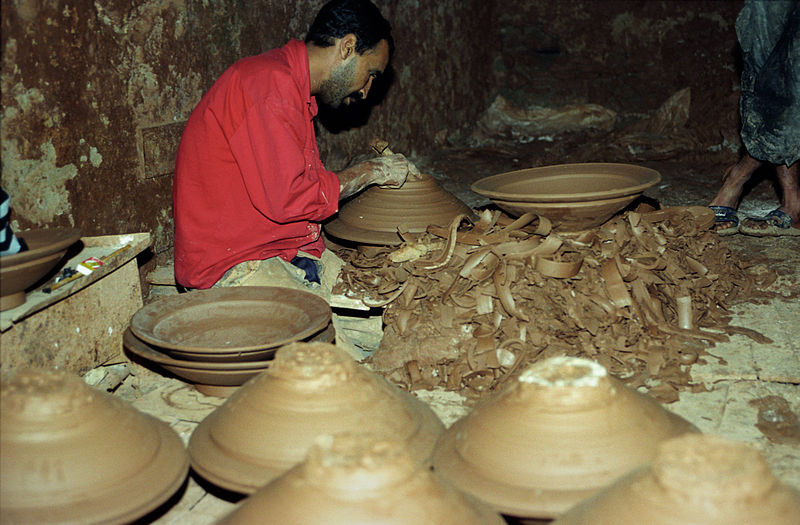
 Tangier (
Tangier (










